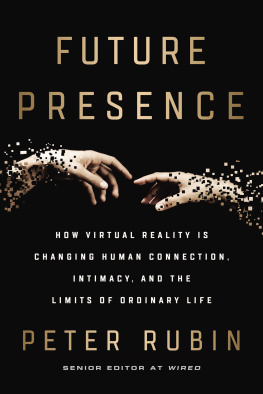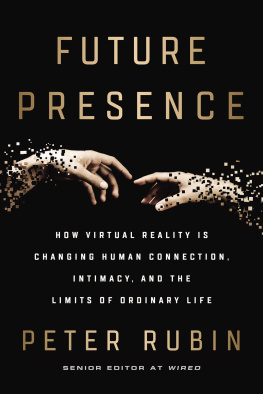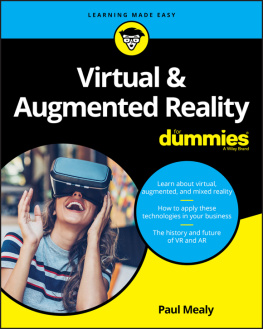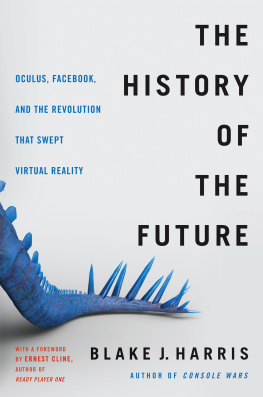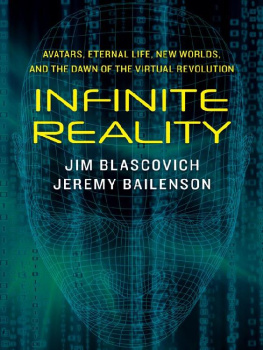Peter Rubin - Future Presence: How Virtual Reality Is Changing Human Connection, Intimacy, and the Limits of Ordinary Life
Here you can read online Peter Rubin - Future Presence: How Virtual Reality Is Changing Human Connection, Intimacy, and the Limits of Ordinary Life full text of the book (entire story) in english for free. Download pdf and epub, get meaning, cover and reviews about this ebook. year: 2018, publisher: HarperOne, genre: Romance novel. Description of the work, (preface) as well as reviews are available. Best literature library LitArk.com created for fans of good reading and offers a wide selection of genres:
Romance novel
Science fiction
Adventure
Detective
Science
History
Home and family
Prose
Art
Politics
Computer
Non-fiction
Religion
Business
Children
Humor
Choose a favorite category and find really read worthwhile books. Enjoy immersion in the world of imagination, feel the emotions of the characters or learn something new for yourself, make an fascinating discovery.
- Book:Future Presence: How Virtual Reality Is Changing Human Connection, Intimacy, and the Limits of Ordinary Life
- Author:
- Publisher:HarperOne
- Genre:
- Year:2018
- Rating:5 / 5
- Favourites:Add to favourites
- Your mark:
- 100
- 1
- 2
- 3
- 4
- 5
Future Presence: How Virtual Reality Is Changing Human Connection, Intimacy, and the Limits of Ordinary Life: summary, description and annotation
We offer to read an annotation, description, summary or preface (depends on what the author of the book "Future Presence: How Virtual Reality Is Changing Human Connection, Intimacy, and the Limits of Ordinary Life" wrote himself). If you haven't found the necessary information about the book — write in the comments, we will try to find it.
Peter Rubin: author's other books
Who wrote Future Presence: How Virtual Reality Is Changing Human Connection, Intimacy, and the Limits of Ordinary Life? Find out the surname, the name of the author of the book and a list of all author's works by series.
Future Presence: How Virtual Reality Is Changing Human Connection, Intimacy, and the Limits of Ordinary Life — read online for free the complete book (whole text) full work
Below is the text of the book, divided by pages. System saving the place of the last page read, allows you to conveniently read the book "Future Presence: How Virtual Reality Is Changing Human Connection, Intimacy, and the Limits of Ordinary Life" online for free, without having to search again every time where you left off. Put a bookmark, and you can go to the page where you finished reading at any time.
Font size:
Interval:
Bookmark:
For Kelli, whose presence is everything.
Contents
W HEN THE VIDEO STARTS , all you can see is an older woman sitting in a chair. She happens to be ninety, though signs of her age are obscured by the black box covering her eyes and nose. What you can see is her mouth, which hangs open in wonder. When the camera pans away from her, it becomes clear that the black box on her face is connected to a laptop computer, which sits open on the table. On the laptop, you can see two images of a green lawn and trees; thats what the woman is looking at in the black box, which is actually an early version of a virtual-reality headset.
Back to the woman the camera swings, and when she speaks, its like something out of a Cheech and Chong movie. Oh, man, she says. Its so reeeeeal! Oh, lordy.
Pretty cool, huh? the young man holding the camera says.
It sure is, she says, looking around. Inside of the box, a screen combines the two nearly identical images into a single three-dimensional one that wraps completely around her. If she turns her head to the right or leftor even turns all the way around in her dining-room chairshe can see everything else in the pastoral scene, from a hill in the distance to the stone villa directly behind her. Is it my eyes, she asks, or are the leaves blowing? Is this really Tuscany?
Someone made this on a computer, another young man in the room says. This is all made by a computer.
If I ever explain this to someone else, says the ninety-year-old woman, they wont believe me.
That sentence, more than any other, gets to the heart of what virtual reality is all about.
Virtual reality (or VR, in the interest of staving off carpal tunnel syndrome) resists description, the way a dream or a memory does. You can tell someone about all the things that you saw and heard while you were wearing a VR headsethow trees looked while you walked in a courtyard on a sunny day, or how waves sounded lapping at the shorebut until someone else has actually tried it, its just words. Its only once that other person has seen (and heard) those things for themselves that they realize whats possible. Imagine seeing television for the first time, or using a smartphone: sure, its easy enough to say its a box with people inside it, but that gets you only about a quarter of the way there. And forget about explaining Tinder or Candy Crush Saga to someone whos never seen a modern phone; theyd just have you hauled away.
New forms of media have always caused seismic shifts in society, from the printing press to the telegraph to a little series of tubes called the internet. But VR isnt simply a new form of media; it sweeps away the barriers of all previous forms. Reading something on paper, hearing a voicemail, and even watching a YouTube video are all enjoyable, yet theyre all limited. Each is a representation of the real thing, but it doesnt actually feel like the real thing at all. Television and phones pale in comparison to what VR offers. For centuries, weve experienced art at a remove, imagining scenes in a book or watching movies on a screen. The imaginary worlds within those things are presented to us, and we appreciate them, but we dont actually experience them. Not truly. Now, with the sensory immersion that VR delivers, we have the ability to become the artto be part of a world, even to be a character.
In the five years since that video first appeared on YouTube, VR has grown from that chunky black box into the biggest technological revolution since the smartphone. (And believe it or not, it took about forty-five years for VR to even turn into that chunky black box. Well get more into that in a bit.) The largest companies in the world have invested billions of dollars in VRand they did that well before a single device had been officially sold in stores.
Why the optimism? Its not just because VR can create the coolest video games weve ever seen; it promises to upend every industry you can name. Entertainment? Good luck being satisfied watching a movie on a screen after youve had the chance to be in the screen, to be there with characters and even have them react to your presence. Travel? No longer do you need to spring for a plane ticket to get some beach time. Education? Take a group of art students to the Louvre without leaving the classroom. VR helps soldiers find relief from post-traumatic stress disorder, and its promise treating chronic pain may one day help it lessen the opioid epidemic. Real estate companies use VR to give clients walkthroughs of homes thousands of miles away. Audi uses it in its showrooms, giving prospective customers the ability to examine anything about any car model, from sitting in the drivers seat to putting their heads inside the engine in order to inspect the inner workings. Through VR documentaries, journalists and governments are putting a face to what would otherwise be abstract in humanitarian concernsby literally putting those concerns on your face. A couple of years ago, a pediatric surgeon in Miami operated on an infant who wasnt expected to survive; later, he attributed his success with a tricky procedure to the fact that hed been able to examine a 3-D scan of the babys heart using VR.
But all that disruption, as people love to call it, is overlooking the thing thats the most disruptive of them all: the way we relate to each other will never be the same. Thats because of something called presence.
Presence is what happens when your brain is so fooled by a virtual experience that it triggers your body to respond as though the experience were real. That might mean the fight-or-flight response kicks in when you find yourself in a dark virtual hallway, raising your heart rate and maybe causing a bead of sweat to trickle down your back. It might mean that you feel an upswell of sympathy or compassion when you meet a fictional creature, or that standing in a grand cathedral and hearing a choir gives you chills. It could also mean that when someonereal, or possibly notmoves close to you and whispers in your ear, or simply looks deeply into your eyes, your skin contracts at the base of your hair follicles, leading to a condition scientists call horripilation and we call goose bumps. (For what its worth, I utterly hate both options.)
Presence is the absolute foundation of virtual reality, and in VR, its the absolute foundation of connectionconnection with yourself, with an idea, with another human, even connection with artificial intelligence. And each one of those things brings with it its own causes and effects. Thats what this book is about: looking at what VR can do, how we react in it, and what those reactions mean for how we relate to each othernow, and in the future.
The age of consumer virtual reality finally, truly dawned in 2016. For a year or two before that, people had been able to buy cheap headsets, View-Master-style cardboard and plastic contraptions: youd drop your phone into one and then strap the thing to your face so that the phones screen became your window to another world. It was cool, and people called it VR, but it wasnt quite. The effect was more like that of one of those old stereoscopes, except it let you spin in a complete circle and see all 360 degrees of a scene. (That didnt stop the New York Times, one week in November 2015, from bagging up a million Sunday papers with one of those cheap headsets. Subscribers could use it with any smartphone running the papers special app and then watch a 360-degree 3-D video documentary about refugee children. Holding the headset to their faces, people found themselves in Syria, Sudan, and Ukraine, seeing the childrens lives with a degree of immersion unthinkable a few short years before. Social media filled with images of people using Google Cardboard with awestruck expressions on their faces.)
Font size:
Interval:
Bookmark:
Similar books «Future Presence: How Virtual Reality Is Changing Human Connection, Intimacy, and the Limits of Ordinary Life»
Look at similar books to Future Presence: How Virtual Reality Is Changing Human Connection, Intimacy, and the Limits of Ordinary Life. We have selected literature similar in name and meaning in the hope of providing readers with more options to find new, interesting, not yet read works.
Discussion, reviews of the book Future Presence: How Virtual Reality Is Changing Human Connection, Intimacy, and the Limits of Ordinary Life and just readers' own opinions. Leave your comments, write what you think about the work, its meaning or the main characters. Specify what exactly you liked and what you didn't like, and why you think so.

